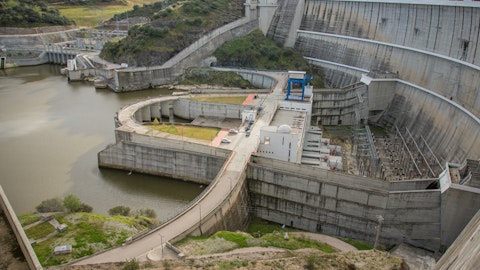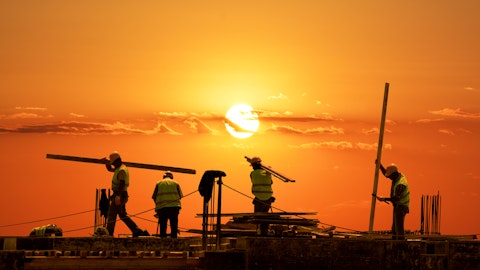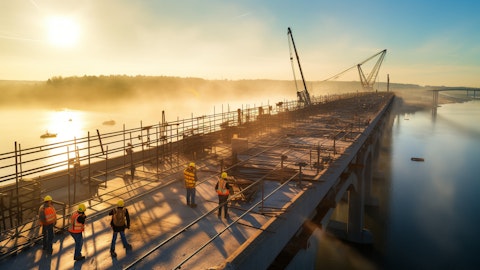Andy Wittmann: Just one last final question, probably for Greg, I’m guessing. I was just kind of curious, when you think about revenues of HMA or aggregates to third parties this first quarter in ’24 versus the first quarter in ’23. Greg, can you talk about how that changed and the impact that had on margins, maybe like total dollars sold to third parties. Just so we can understand how much of a component of your revenue mix, that part of your business was?
Greg Hoffman: Yes, absolutely. So I guess, first of all, let me say that particular area of sales revenue for us is focused more in the commercial private market. So like internally, we noticed that, that was still a very strong component of our business. So it’s really good to see. I think just another internal indicator for us that activity is still strong. We are typically in the 10% to 12%. I think we’ve talked about before of third-party sales of both aggregate and hot mix asphalt each year in our revenue.
Andy Wittmann: And there wasn’t a change this year versus last year still kind of consistently in that range.
Greg Hoffman: Still pretty consistent, yes.
Operator: Our next question comes from the line of Michael Feniger with Bank of America. Please proceed with your question.
Michael Feniger: Just I think you might have touched on it a little bit maybe with weather in January. Just curious with such a strong start to the year, any reason to not raise the full year outlook? Was there anything that kind of stuck out to you? Is there anything we should be aware of that you’re implying maybe just with margins maybe in the last the next 9 months that changed your expectations from coming into the year? .
Jule Smith: No, Michael. Not at all. I’m glad you asked that question. We typically look at our business as 2 halves of the year. And so that’s why we talk about our revenue is 40-60 of our EBITDA is typically 30-70. We just try to just get through the first 2 quarters and then assess our business at midyear. And so we feel good about our guidance. There’s nothing we’re doing other than just saying we’re reaffirming that. We’ll take a good hard look at it after the second quarter in our mid-year.
Michael Feniger: And just with the quarter, anything you touch on with the margin on — we obviously saw there’s lower diesel, maybe liquid asphalt. Just was that a benefit to the margin in Q1? And how are you thinking about where that — those prices are today what it means kind of for the next 3 quarters if it stays at this level?
Greg Hoffman: Yes, Michael. I think — but we always say is that when there is some downward pricing and energy costs. We do get a little tailwind. And when it goes up, we see a little headwind. And I don’t think that has changed. I think if you look back over the last 12 to 18 months, primarily diesel and natural gas have fluctuated within a pretty tight range. It seems like it was more back in early 2022 when it kind of spiked up. So I think we’re operating within a pretty decently stable range and certainly taking those slight tailwinds when we can get them.
Michael Feniger: And just my last one. Obviously, we’re going into an election year. I’m curious if you can hear on the ground of does that create any uncertainty you think of your business? Or is this less of a concern maybe compared to prior election years because you do have that legislation IIJA that was passed — just curious kind of how we think about that in election year with some of the funding and if it’s a little different this go around than maybe what you have seen in other prior election years.
Jule Smith: Michael, good question. The good thing for us is in Washington, D.C. certainly has a lot of things they argue about, but infrastructure funding is probably the most bipartisan thing in Washington. And so both parties see the need to invest in the nation’s infrastructure, they always have. And so we really don’t see the election, however it turns out, really affecting the funding for the IIJA or the surface transportation funding overall. So clearly, we want the economy to remain strong and stable, and — but we really don’t think the election is going to have a big impact on our business.
Operator: Our next question comes from the line of Stanley Elliott with Stifel. Please proceed with your question.
Stanley Elliott: Talk about like when you all would expect your backlog logs to normalize? I mean, it looks like you’ve got covered for the rest of the year. Curious if we should see some improvement on the organic side. How can you flex the labor component to maybe to add above the 7-plus percent sort of numbers you guys are looking at on the organic side?
Jule Smith: Stanley, I’ll address the backlog first and then organic growth. The — our backlog was set another record this quarter. And so I think that’s 13 quarters in a row, which is very atypical for CPI. In that our backlog sequentially has always tended in the busy season to go down when we’re burning off a lot of backlog. And so that indicates 2 things. Number one, we’re growing and number two, it’s an active bid environment. But at some point — we can only sell but so much ahead of our resources. And so at some point, it’s not going to surprise us at all for it to — our backlog to go down sequentially. So — but it does give us good visibility. It does allow us to stay patient at the bid table, which are great things.
On the organic growth side, we continue to focus heavily on organic growth. And you’re right to do that, we have to add labor. And so we continue to add labor and equipment and to invest in organic growth. As Greg said, beyond maintenance CapEx, we add equipment, we hire people and try to invest in high-value growth initiatives on the organic side.
Stanley Elliott: And then in terms of kind of the backlog or the pipeline of work, any kind of drill down color you guys could share on maybe some of the states that you guys are seeing the most activity? I’m just curious to try to get a little sense within the portfolio there.
Jule Smith: Well, I would say all 6 states, we have active bid environments. So there’s no state that I would say is any concern. Clearly, when you look at our states of Florida and Tennessee and South Carolina are just — have great funding programs and are very, very active. Florida is clearly experiencing just an incredible amount of migration. But so as Tennessee and South Carolina. North Carolina has a very healthy funding mechanism. So it’s — Georgia, is great. I mean it’s — there’s — all of our platform companies are adding work to backlog and bidding a lot of work. So we’re blessed in that regard.
Operator: Our next question comes from the line of Adam Thalhimer with Thompson Davis. Please proceed with your question.
Adam Thalhimer: I got to be honest, Stanley stole all my questions. Maybe I’ll just double up. I was curious on kind of your expectations for DOT bidding in the next few months.
Jule Smith: Well, we’ve got quite a bit to bid on. The DOT, as you know, doesn’t bid evenly throughout the year. A lot of their work does bid in the next few months. in some of our states. And so we’ve got a pretty big letting in North Carolina this month and South Carolina here next week. So there the winter time they let a lot of work that they want to do in the spring and summer. And so it’s pretty active.
Adam Thalhimer: And then, Jule, any of the ankle weights still hanging around? I was curious if labor is getting a little bit better.
Jule Smith: I would say it’s pretty much normal now, Adam. I mean, clearly, the generational, as I’ve talked about, the generational just retiring of our workforce makes it harder to find skilled operators, but I think that’s an advantage for us because we’re going to do what it takes to attract and retain a workforce. And so we see that as an advantage that we’re going to try to leverage. But as far as just finding labor to fill our crews, the annual raises the cost of labor. It just — it’s back to normal. It’s a pass-through cost that is not out of control like it was right after COVID and the reopening of the economy. So I would definitely say, I don’t feel like we’re running with any ankle weights now.
Operator: [Operator Instructions] Our next question comes from the line of Brent Thielman with D.A. Davidson. Please proceed with your question.
Brent Thielman: Lot coverage or, I guess, just a couple here, Joel. Joel, the fact that your markets are so good impacting your ability to do deals as fast as you like. Your results are solid. I assume many of the potential targets are, too. Just wondering if that’s have an impact on so or expectations or so or expectations reasonable?
Jule Smith: Yes, Brent, that’s a good question and 1 that we get asked a lot. And the reality is the markets and them being solid, really don’t play into our sellers thoughts because our sellers are thinking more long term with what’s best for their family. And they’re doing family generational planning and what they’ve made a lot of money in this business for decades. And so they’re really not looking at the short-term market. And so I really haven’t seen any change in their expectations. I really haven’t seen anything about the current funding making them less willing to sell. We’re in a lot of conversations throughout the Southeast in the Sunbelt with potential sellers. That’s — our pipeline is active. So — but the markets being healthy really isn’t a big consideration for them. It’s more what’s best just for the overall business and their families long term.



